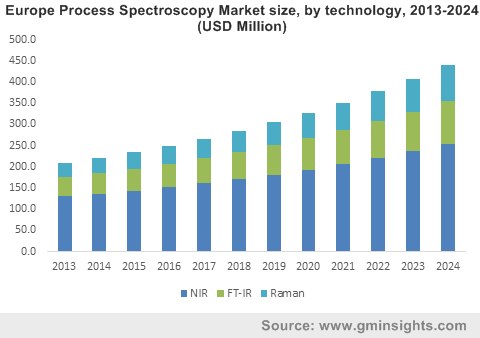Process spectroscopy market to cross a billion mark by 2024, NIR technology to exhibit significant adoption rate
Publisher : Fractovia | Published Date : 2017-05-05Request Sample
Over the recent years, Process Spectroscopy Market has witnessed a phenomenal upswing, the credit of which can primarily be given to the rising demand for accuracy and quality control in product manufacturing. In order to save valuable time and money, companies are focusing to reduce expenditure by lessening the re-work and errors. In this regard, market participants are widely adopting the process spectroscopy technique to measure and monitor their work processes. Regulatory bodies worldwide are also expected to partake heavily in the deployment of process spectroscopy to enable an efficient work procedure. Evident from the massive applications of this technique, the global process spectroscopy market is certain to witness a heavy surge in the years ahead with a CAGR estimation of 6.5% over the period of 2016-2024.
Europe Process Spectroscopy Market size, by technology, 2013-2024 (USD Million)

Rising cognizance among people regarding the product quality and standards clubbed with governmental regulations across several industries is mainly encouraging the market players to follow the international quality guidelines. Companies now have also started to implement these monitoring measures to achieve these certifications, which in turn will improve their process effectiveness, product quality, and cost savings.
The process spectroscopy technologies include Fourier Transform Infrared (FT-IR), Near infrared (NIR) and Raman spectroscopy. Effective implementation of these technologies is likely to offer low production & inspection cost, efficient utilization of resources, consumer satisfaction and increase in sale. The FT-IR technology based process spectroscopy industry is estimated to account for more than 20% of the overall industry share by 2024, having had collected USD 170 million revenue in 2015. Growing penetration of this technology for assessment and identification of various chemicals, compounds, and materials is fueling the growth of this technology in the process spectroscopy industry.
The NIR technology based process spectroscopy market accounted more than 60% of the overall industry share in 2015. Rising application of this technology in food industry, polymer, oil & gas, and pharmaceuticals industries is likely to produce high avenues for process spectroscopy market. This technology is also used in chemical industry for plastic identification. Over the time span of coming seven years, the NIR technology is expected to be the largest technology segment.
Intensive quality assessment, high production, and customization required in the polymer industry has propelled the process spectroscopy market share in this sector to record a growth rate of 6.2% over the period of 2016-2024. In 2015, the polymer sector occupied more than 16% of the overall process spectroscopy market share.
The global process spectroscopy market has experienced a tremendous growth in its market valuation with the increasing adoption of Raman spectroscopy in food & agriculture and pharmaceutical industry. Raman spectroscopy is becoming a viable industrial technique as this technology is non-destructive and non-contacting. The pharmaceutical industry is a convincing example where this technology is highly used in the analysis of salt forms & polymorphs. The global process spectroscopy market is witnessing a major spur from the Raman spectroscopy technique, which is progressing rapidly attributed to its wide spectrum of advantages. This technology is eventually to become the most popular analytical measurement tool for pharmaceutical applications ranging from the verification of raw materials to the quality check of the product and to synthesis of new drug.
One such step of analytical measurement was taken by the Food and Drug Administration (FDA) by formulating the Process Analytical Technology (PAT) framework. This concept was designed with an aim to ensure high quality performance in pharmaceutical manufacturing. The execution of PAT framework in pharmaceutical industry by FDA in the United States is estimated to showcase potential impact on the process spectroscopy industry of North America.
Existence of significant industry giants and strict quality standards in healthcare, food, and agriculture sectors of U.S. is projected to chart a promising growth curve for process spectroscopy market.
Cheap workforce and abundant availability of resources in Asia Pacific is prompting major companies to relocate their manufacturing base in this region. APAC process spectroscopy market share is set to record a CAGR of 8% over the period of 2016-2024.
The key participants in the process spectroscopy market accumulating include Danaher, Bruker, ABB, Horiba Buchi and Agilent Technologies. Other prominent industry participants are Samsung, Eureka Forbes, iRobot, LG, Panasonic, Haier, Bissell, Royal Philips Electronics.